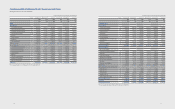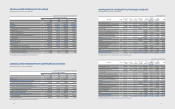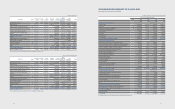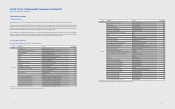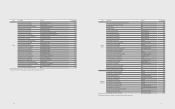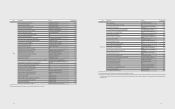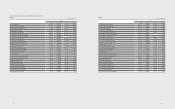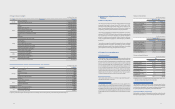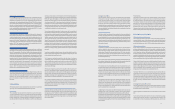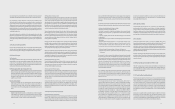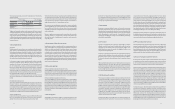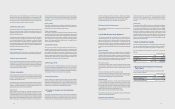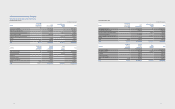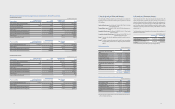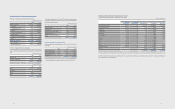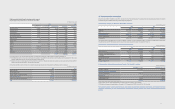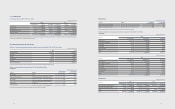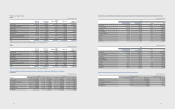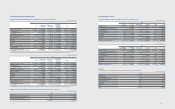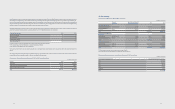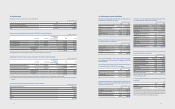Samsung 2012 Annual Report Download - page 35
Download and view the complete annual report
Please find page 35 of the 2012 Samsung annual report below. You can navigate through the pages in the report by either clicking on the pages listed below, or by using the keyword search tool below to find specific information within the annual report.
The Company policy is that assets should be depreciated over the following
estimated useful lives:
Estimated useful
lives
Estimated useful
lives
Buildings and
auxiliary facilities 15, 30 years Tools and xtures 5 years
Structures 15 years Vehicles 5 years
Machinery and
equipment 5 years
Tangible assets’ depreciation methods, residual values and useful lives are reviewed,
and adjusted if appropriate, at the end of each reporting period. An asset’s carrying
amount is written down immediately to its recoverable amount if the asset’s
carrying amount is greater than its estimated recoverable amount. Gains and losses
on disposals are determined by comparing the proceeds with the carrying amount
and are recognized within the statement of income as part of other non-operating
income and expenses.
2.12 Intangible Assets
(A) Goodwill
Goodwill represents the excess of the cost of an acquisition over the fair value of the
group’s share of the net identiable assets of the acquired subsidiary, associates,
joint ventures and businesses at the date of acquisition. Goodwill on acquisitions
of subsidiaries and businesses is included in intangible assets and goodwill on
acquisition of associates and joint ventures are included in the investments in
associates and joint ventures. Gains and losses on the disposal of an entity include
the carrying amount of goodwill relating to the entity sold.
For the purpose of impairment testing, goodwill acquired in a business combination
shall, from the acquisition date, be allocated to each of the acquirer’s cash-
generating units, or groups of cash-generating units, that is expected to benefit
from the synergies of the combination, and the allocation shall be determined
based on the operating segments. Goodwill is tested annually for impairment
and carried at cost less accumulated impairment losses. Goodwill is tested for
impairment annually or more frequently if there is any indication that it may be
impaired. Goodwill is tested for impairment by comparing the carrying amount of
the cash-generating units or groups of cash-generating units with the
recoverable amount, which is the higher of its fair value less costs to sell and its
value in use. An impairment loss is immediately recognized and is not subsequently
reversed.
(B) Capitalized development costs
The Company capitalizes certain development costs when the outcome of a
development plan is for practical enhancement, probability of technical and
commercial achievement for the development plans are high, and the necessary
cost is reliably estimable. Capitalized costs, comprising direct labor and related
overheads, are amortized on a straight-line basis over their useful lives. In
presentation, accumulated amortization and accumulated impairment amounts
are deducted from capitalized costs associated with development activities.
(C) Other intangible assets
Certain membership dues are regarded as having an indenite useful life because
there is no foreseeable limit to the period over which the asset is expected to
generate net cash inows for the entity, and such assets are not amortized.
Trademarks and licenses which are separately acquired are presented at historical
cost. Trademarks and licenses which are acquired in business combinations are
recorded at the fair value at the acquisition date. They have definite useful lives
and are measured at cost less any accumulated amortization and amortized on a
straight-line basis over their 5 or 10 year estimated useful lives.
The contractual customer relationships were acquired in a business combination
and are recognized at fair value at the acquisition date. The contractual relationships
have a definite useful life and are recorded at cost less any accumulated
amortization and amortized on a straight-line basis over the estimated period of the
customer relationship.
Software is capitalized and amortized using the straight-line method over their
useful lives, generally 5 to 10 years. Where an indication of impairment exists,
the carrying amount of an intangible asset is assessed and written down to its
recoverable amount.
2.13 Impairment of Non-Financial Assets
Intangible assets that have an indenite useful life, for example goodwill, are not
subject to amortization and are tested annually for impairment. Assets that are
subject to amortization are reviewed for impairment whenever events or changes
in circumstances indicate that the carrying amount may not be recoverable.
An impairment loss is recognized for the amount by which the asset’s carrying
amount exceeds its recoverable amount. The recoverable amount is the higher
of an asset’s fair value less costs to sell and value in use. For the purposes of
assessing impairment, assets are grouped at the lowest levels for which there are
separately identiable cash ows (cashgenerating units). Non-nancial assets other
than goodwill that suffered impairment are reviewed for possible reversal of the
impairment at each reporting date.
2.14 Financial Liabilities
(A) Financial liabilities at fair value through prot or loss
GFinancial liabilities are acquired or incurred principally for the purpose of selling or
repurchasing in the near term. Financial liabilities at fair value through prot or loss
of the Company consist of derivatives which are not subject to hedge accounting
and derivatives separated from nancial instruments such as embedded derivatives.
(B) Financial liabilities measured at amortized cost
Unless nancial liabilities arise when transfer of nancial assets or nancial liabilities
at fair value through prot or loss do not qualify for derecognition, all non-derivative
nancial liabilities are classied as nancial liabilities measured at amortized cost.
If a transfer does not result in derecognition, the Company continues to recognize
the transferred asset and a nancial liability for the consideration received. Financial
liabilities measured at amortized cost, due within twelve months after the balance
sheet date, are classied as current liabilities, otherwise, they are classied as non-
current liabilities.
2.15 Trade Payables
Trade payables are amounts due to suppliers for merchandise purchased or services
received in the ordinary course of business. If payment is expected in one year or
less (or in the normal operating cycle of the Company if longer), they are classied
as current liabilities. If not, they are presented as non-current liabilities. Non-current
trade payables are recognized initially at fair value and subsequently measured at
amortized cost using the eective interest method.
2.16 Borrowings
Borrowings are recognized initially at fair value, net of transaction costs and are
subsequently measured at amortized cost. Any dierence between cost and the
redemption value is recognized in the statement of income over the period of the
borrowings using the eective interest method. If the Company has an indenite
right to defer payment for a period longer than 12 months after the end of the
reporting date, such liabilities are recorded as non-current liabilities, otherwise, they
are recorded as current liabilities.
2.17 Provisions
A provision is recognized when the Company has a present legal or constructive
obligation as a result of a past event, it is probable that an outflow of resources
embodying economic benefits will be required to settle the obligation, and a
reliable estimate can be made of the amount of the obligation. Provisions are not
recognized for future operating losses.
Provisions are measured at the present value of the expenditures expected to be
required to settle the obligation using a pre-tax rate that reects current market
assessments of the time value of money and the risks specific to the obligation.
The increase in the provision due to the passage of time is recognized as interest
expense.
When it is probable that an outow of economic benets will occur due to a present
obligation resulting from a past event, and the amount is reasonably estimable, a
corresponding provision is recognized in the nancial statements. However, when
such outflow is dependent upon a future event, that is not certain to occur, or
cannot be reliably estimated, a disclosure regarding the contingent liability is made
in the notes to the nancial statements.
2.18 Dened Benet Liabilities
The Company has a variety of retirement pension plans including dened benet
or dened contribution plans. A dened contribution plan is a pension plan under
which the Company pays xed contributions into a separate entity. The Company
has no legal or constructive obligations to pay further contributions if the fund
does not hold sufficient assets to pay all employees the benefits relating to
employee service in the current and prior periods. For dened contribution plans,
the Company pays contributions to annuity plans that are managed either publicly
or privately on a mandatory, contractual or voluntary basis. The Company has no
further future payment obligations once the contributions have been paid. The
contributions are recognized as employee benefit expense when they are due.
Prepaid contributions are recognized as an asset to the extent that a cash refund or
a reduction in the future payments is available.
A defined benefit plan is a pension plan that is not a defined contribution plan.
Typically defined benefit plans define an amount of pension benefit that an
employee will receive on retirement, usually dependent on one or more factors
such as age, years of service and compensation. The liabilities recognized in the
statement financial position in respect of defined benefit pension plans are the
present values of the dened benet obligations at the end of the reporting period
less the fair value of plan assets. The dened benet obligation is calculated annually
by independent actuaries using the projected unit credit method. The present
value of the dened benet obligation is determined by discounting the estimated
future cash outows using interest rates of high-quality corporate bonds that are
denominated in the currency in which the benets will be paid and that have terms
to maturity approximating to the terms of the related pension liability.
Actuarial gains and losses resulting from the changes in actuarial assumptions, and
the dierences between the previous actuarial assumptions and what has actually
occurred, are recognized in other comprehensive income in the period in which it
was incurred. Past service costs are immediately recognized in prot and loss.
2.19 Financial Guarantee Contract
Financial guarantee contracts are contracts that require the issuer to make specied
payments to reimburse the holder for a loss it incurs because a specied debtor fails
to make payments when due. Financial guarantees are initially recognized in the
nancial statements at fair value on the date the guarantee was given. If the amount
measured in subsequent periods exceeds the unamortized balance of the amount
initially recognized, the excess is classied as another nancial liability.
2.20 Income Tax Expense and Deferred Taxes
The tax expense for the period comprises current and deferred tax. Tax is recognized
in the statement of income, except to the extent that it relates to items recognized
in other comprehensive income or directly in equity. In this case the tax is also
recognized in other comprehensive income or directly in equity as appropriate.
Deferred income tax is recognized on temporary dierences arising between the tax
bases of assets and liabilities and their carrying amounts in the consolidated nancial
statements; it is the future tax consequences of the future recovery or settlement
of the carrying amount. However, the deferred income tax is not accounted for if
it arises from initial recognition of an asset or liability in a transaction other than a
business combination that at the time of the transaction aects neither accounting
nor taxable profit or loss. Deferred income tax is determined using tax rates (and
laws) that have been enacted or substantively enacted by the balance sheet date
and are expected to apply when the related deferred income tax asset is realized or
the deferred income tax liability is settled. Deferred income tax assets are recognized
only to the extent that it is probable that future taxable prot will be available against
which the temporary dierences can be utilized.
An entity shall recognize a deferred tax liability for all taxable temporary dierences
associated with investments in subsidiaries, associates, and interests in joint
ventures, except to the extent that the parent company is able to control the timing
of the reversal of the temporary difference, and it is probable that the temporary
difference will not reverse in the foreseeable future. An entity shall recognize a
deferred tax asset for all deductible temporary dierences arising from investments
in subsidiaries and associates, and interests in joint ventures, to the extent that the
temporary dierence will reverse in the foreseeable future and taxable prots will be
available against which the temporary dierence can be utilized.
6766


